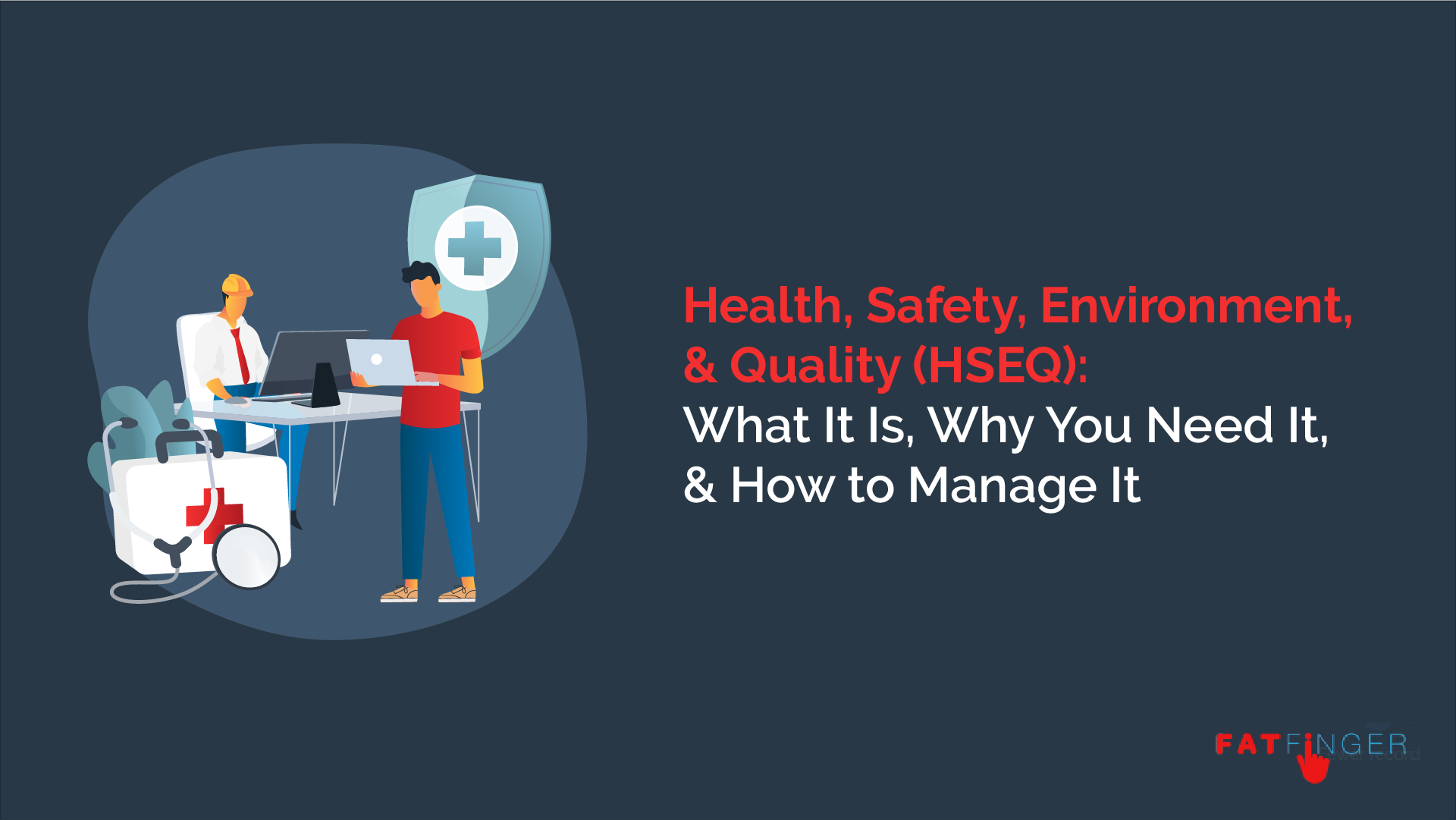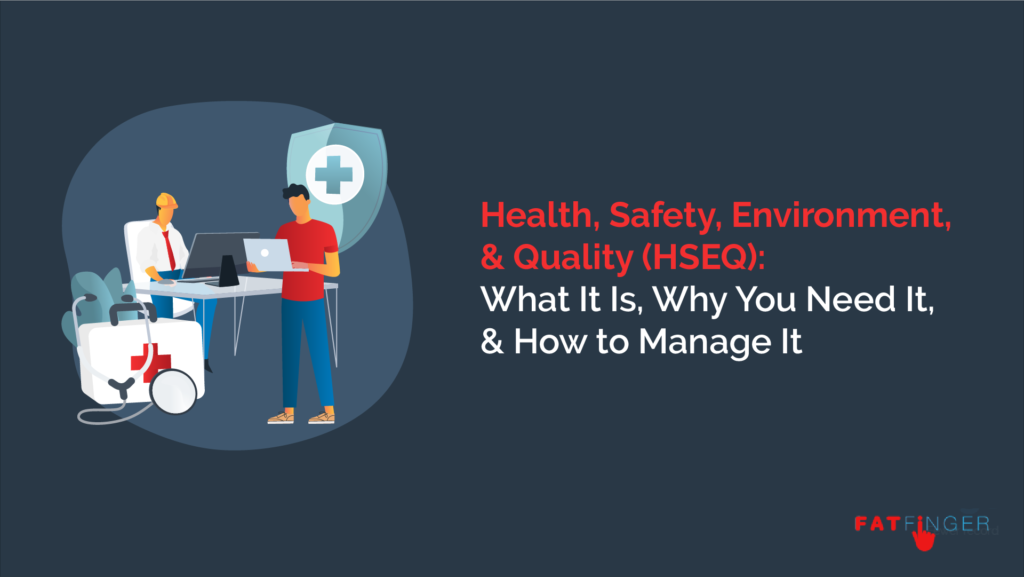
When speaking of workplace safety management, the Health, Safety, Environment, & Quality (HSEQ) framework often comes up.
Industries such as mining, oil and energy, engineering, and manufacturing are quite often associated with injury statistics such as the following:
- 14 people die every day from workplace injuries.
- The average number of days a worker needs to take off due to workplace health issues is eight.
- One of the biggest contributors to greenhouse gas emissions comes from industrial and commercial businesses like yours
- Costs associated with producing poor quality products can often be between 15-20% of an organization’s sales revenue.
But how can you prevent these workplace hazards and promote a safety culture?
To prevent incidents such as people dying in your workplace, stop them from suffering from work-related health issues, lower your production of greenhouse gasses, and improve product quality, you need to use the Health, Safety, Environment, & Quality (HSEQ) framework for risk management.
Sorry, what?!
Don’t worry! All will become clear as we go through this FAT FINGER post and answer this questions:
- What is the HSEQ framework and what is its role in safety management?
- Why you should use the HSEQ framework?
- How can you implement the HSEQ framework in your organization?
What is The HSEQ Framework?
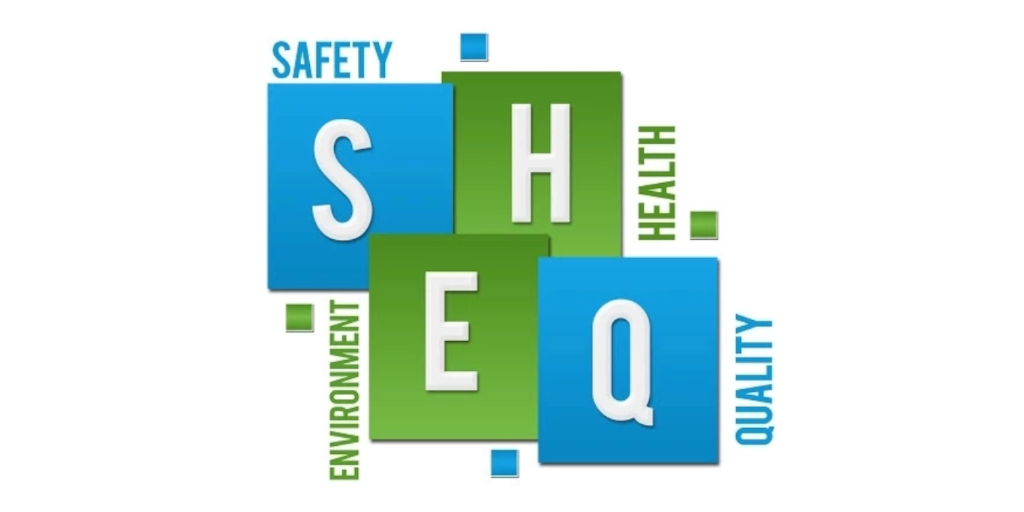
Health, Safety, Environment, and Quality (HSEQ) is a framework that allows you to analyze and implement practical measures to mitigate the health, safety, environmental, and quality risks that may affect your organization, employees, and customers.
Let’s look at each component of the framework separately to see exactly what HSEQ means and how it applies to you and your organization.
What Does Health Stand For in the HSE Framework?

“Healthy employees are more productive, have fewer absences, and are less prone to work-related injury”
Statista, Workplace Health and Wellness in the U.S. – Statistics & Facts
Your employees are likely to spend about one-third of their lives at work. That’s the equivalent of 90,000 hours. That’s a lot of time, right?
So, when they’re at work what happens if your employees become overworked? Or they experience sub-standard working conditions? What happens if they don’t have the right equipment to do their jobs properly? Or if they don’t receive enough support?
Their health suffers.
They become ill, experience injuries, become less productive, and often need time off work. This is not only incredibly harmful to them, but it’s also incredibly destructive for your company.
But this is where the HSEQ framework can help.
The Health aspect of the HSEQ framework allows you to develop robust occupational health processes, working practices, and activities that can prevent or lower the risk of harm to your employees.
OHSAS 18001 (succeeded by ISO 45001) are some of the ISO standards that guide the health part of hseq.
What Does Safety Stand For in HSE?
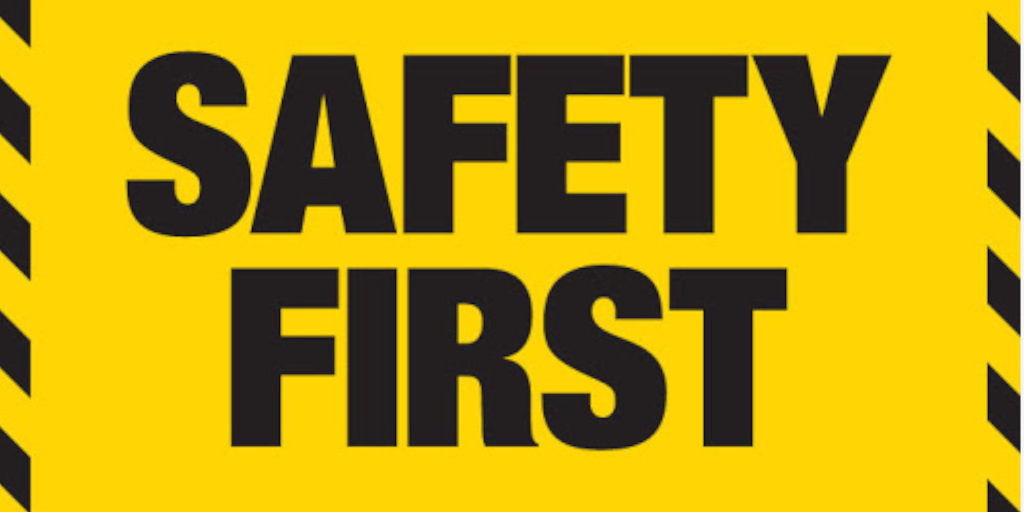
“Perhaps you think work-related deaths, injuries and illnesses are infrequent, or only affect workers in demonstrably risky jobs—like mining or construction. The actual statistics, however, tell a different story.”
Scientific American, The Health and Safety of America’s Workers Is at Risk
As we established earlier, 14 people die every day from workplace accidents and injuries. 14 people! According to statistics, that means there’s a workplace death every 99 minutes.
Fatalities can be the result of a seemingly minor event such as a slip, trip, or fall in the workplace or a bigger, catastrophic event like the direct exposure to a hazardous chemical or an unexpected explosion.
Regardless of whether you run a “safe” office-based business or a large “hazardous” construction company, the ‘Safety’ arm of the HSEQ framework will allow you to create procedures that identify and minimize workplace hazards. Take 5 safety and job safety analysis are examples of safety measures in place to reduce accidents and exposure to harmful situations and substances.
What Does Environment Stand For in HSE?

“The world could run out of rain forests in 2100, food in 2050, fish in 2048, water in 2040…”
The World Counts, Planet Earth
Around 90% of the world’s fish stocks have been depleted and are on the brink of collapse. Each year 7 million people die prematurely as a result of poor air quality. There are currently 5.2 trillion plastic particles floating in the world’s oceans, and since 2008 over 21 million people have been forced to move locations because of climate change.
We all need to do our bit for the planet and that includes businesses.
The ‘Environment’ part of the HSEQ framework, as guided by ISO 14001, enables you to follow and comply with recommended environmental management best practices to reduce your company’s carbon footprint.
What Does Quality Stand For in the HSE Framework?

“Poor quality can weaken consumer relationships, damage your brand, and add major operational and financial costs.”
Sourcing Journal, Understanding the True Cost of Poor Quality and How to Reduce It
We’re talking over $2 billion over the course of 5 years for some.
I think we can all agree that quality plays an essential part in the success or failure of your business. This is why the HSEQ framework encourages you to create quality management processes to check, control, and manage the quality of your products or services.
We’ll dig deeper into the ‘Quality’ component, and the other three aspects of the HSEQ framework, as we make our way through the rest of this post.
Before we do though, here’s a summary of what we’ve covered so far:
The HSEQ framework is a commitment to the health & safety of employees, the protection of the environment, and the satisfaction of customers.
Why Should You Use The HSEQ Framework? The 5 Main Benefits of HSEQ
We’ve already touched on the Health, Safety, Environmental, and Quality management reasons for adopting the HSEQ framework into your organization, but there’s more…
1. HSEQ Increases Efficiency & Revenue 📈
The HSEQ framework suggests you should create and follow processes that adhere to industry best-practices around health, safety, environment, and quality. Following best practice processes like these will improve overall operational efficiency, lower costs, and increase revenue.
2. HSEQ Improves employee morale 😀
Implementing policies and protocols that ensure a safe and healthy work environment means employees will feel more secure and motivated about their work.
3. HSEQ Increases Customer Satisfaction 👍
Developing quality control processes within the HSEQ framework means errors will be reduced which will increase customer confidence in your ability to consistently deliver high-quality products and services.
4. HSEQ Minimizes the Risk of Fines or Legal Action ⚖️
Increased awareness of, and compliance with, standards, legal obligations, and legislations surrounding health, safety, environment, and quality will minimize the risk of legal action.
5. HSEQ Improves Corporate Image 🤩
Using the HSEQ framework will show your customers, suppliers, and employees that your business cares about the welfare of its employees, the quality of its products and services, and the importance of the environment.
But how do you implement the HSEQ framework in your organization?
Good question… 🧐
How to Implement the Health, Safety, Environment, & Quality (HSEQ) Framework in Your Organization
To explain how to implement a compliant and effective HSEQ framework into your organization, one that allows you to mitigate risks in your company, I’ll break the concept down into separate components again.
EQ: How to create and apply Health & Safety protocols
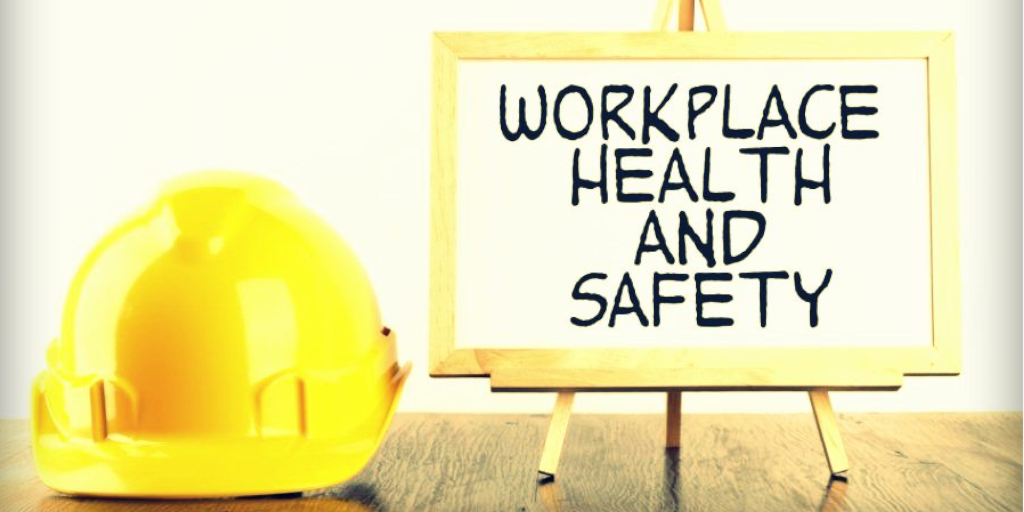
To make sure your staff are healthy and safe while at work, you need to develop and enforce stringent health and safety protocols, and regularly assess them to make sure they remain effective.
To manage your occupational health and safety, you need to create a set of processes that a) meet ISO 45001 health and safety standards, and b) enables you to:
- Provide and maintain a safe work environment where:
- The equipment you provide is safe and up-to-date
- Your employees have safe access to, from, and around the workplace
- The building is kept at a reasonable temperature
- Enough air ventilation points are provided
- The toilet facilities are kept clean
- Floors and surfaces aren’t slippery
- Identify hazards that could cause accidents or injuries, and develop methods to assess, control, remove, or minimize those risks
- Provide employees with information, instructions, training, and supervision to enable them to perform their duties in a safe and healthy way
- Provide guidelines for the safe use, handling, and storage of chemicals and other toxic or hazardous substances
- Ensure a system is in place to report work-related incidents, injuries, and illnesses
- Undertake a regular review of health and safety performance and establish objectives and targets to ensure that the possibility of work-related injury and illness is kept at a minimum
Create and Apply Health & Safety Protocols With FAT FINGER
The easiest way to build and manage occupational health and safety processes is to use a business process management platform, like FAT FINGER.
FAT FINGER is a no-code application building platform that allows you to build procedures, processes, and workflows in seconds. Use the intuitive drag-and-drop editor to create templates and run individual checklists from these templates each time you or your team needs to complete a process. It couldn’t be easier to use FAT FINGER, but watch this video to get a quick overview:
Create your HSEQ health and safety templates from scratch or use our free pre-made templates and edit them to suit your needs. Complete your procedures from wherever you are on whatever device you are using at the time. Assign tasks to your team, receive notifications when something needs to be done, and connect your workflows to your existing platforms, tools, and apps to push and pull data in real-time.
So, sign up for a free trial now, and grab these pre-made health and safety checklists:
- Health and Safety Observation Report Checklist
- Construction Site Health and Safety Audit
- Emergency Lighting Inspection Log Checklist
Once you’ve created your HSEQ health and safety processes, to make sure they are ISO 45001 compliant, you can audit them using this ISO 45001:2017 Checklist.
“Operating under standards like ISO harmonizes management structure, providing a common framework for integrated Health, Safety, Environment and Quality (HSEQ).”
Industry, Safety, & Hygiene News, Harmonizing ISO Standards with an Integrated HSEQ System
HSQ: How to create and apply Environmental policies

You and your employees need to make sure that your organization is adhering to specific environmental regulations that are aimed at reducing your company’s carbon footprint.
To do this, you need to create and follow HSEQ environmental processes that meet ISO14001 standards and allow you to:
- Comply with the requirements of all applicable environmental laws, regulations, and standards
- Investigate and respond to any work-related environmental incidents
- Communicate with employees and regulatory bodies to increase awareness and resolve work-related environmental issues
- Establish a set of clear objectives to ensure that your organization continues to eliminate environmental incidents
- Adopt best practices around and reducing waste, lowering emissions, conserving water, and supporting pollution prevention
Creating HSEQ environmental processes that are ISO14001 certified will allow you to develop and implement specific policies and procedures that train staff, identify potential environmental problems, monitor issues, and report on environmental performance.
Use FAT FINGER to create environmental procedures like these for example:
- Health, Safety and Environmental Audit – Office Environment
- Environmental Services Manager Inspection Checklist
- MMH Environmental Services Inspection Checklist
Then, once you’ve created all your processes, to make sure they adhere to ISO14001 standards, use this ISO14001 Preliminary Audit Checklist (for free of course!)
HSE: How to create and apply Quality processes

To ensure you’re continuously producing high-quality products or services and keeping your customers happy, you need to implement quality management processes that meet ISO 9001 standards and allow you to:
- Implement and maintain a quality management system so you can review all your key performance processes
- Train and maintain a workforce so they have the knowledge and capability to consistently deliver to high-quality standards
- Perform regular tests and maintenance on equipment
- Meet all legal standards and requirements
Building a set of quality management processes that are ISO 9001 compliant will streamline your quality control processes, reduce errors, and improve internal communications. This in turn will increase staff morale, improve customer retention, and attract healthier revenues.
Use FAT FINGER to create quality control processes like these for example:
- Quality Control Sheet Checklist
- Quality Control Inspection Checklist
- Gas Operative Quality Control Checklist
Then, once you’ve created your quality management processes, use this ISO 9001:2008 System Audit Checklist to make sure they are ISO 9001 compliant. This will demonstrate that you’re customer-focused and committed to delivering a high-quality service.
To conclude…
Upholding workplace health and safety is paramount. Reducing the impact your organization has on the environment is vital, and ensuring the consistent quality of your products and services is key.
By integrating systemic HSEQ processes into your workplace, you can:
- Mitigate risks
- Reduce work-related hazards that affect your employees
- Guarantee high health, safety and quality standards
Ready to efficiently manage health, safety, environment, and quality (hseq) in your organization?


